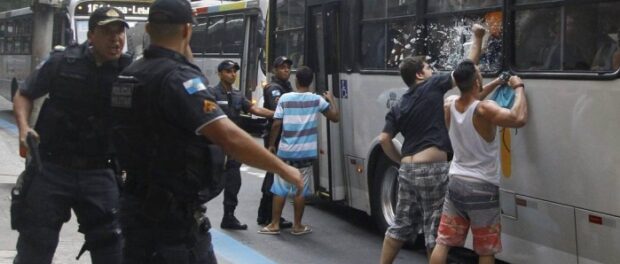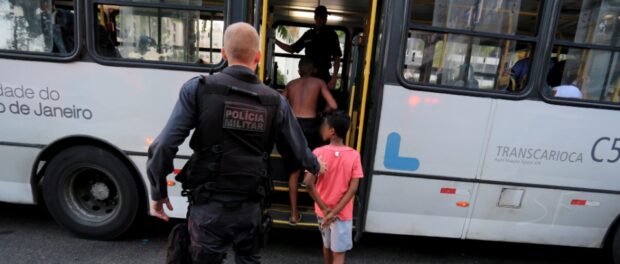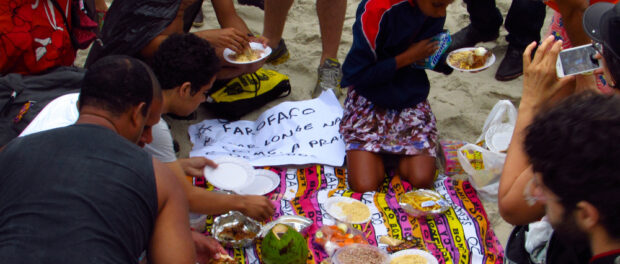
Tension between Rio de Janeiro’s North and South Zone residents has reached a new peak because of the threat of violence on Rio’s beaches in this pre-Olympic year. On August 23, buses filled with around 150 teens were stopped in Botafogo, on their way to the South Zone beachside neighborhoods on the pretense that youth on board were coming with intentions to rob and engage in violence. The young people were detained and taken to the Integrated Center for Assistance to Children and Adolescents (CIACA) without having committed a crime.
One teenager said: “We were thrown to the dirty floor to wait because they thought we were thieves just because we are black.” Rio de Janeiro’s governor, Luiz Fernando Pezão, commented that this precautionary measure is being taken by the Military Police to prevent arrastões, as mass robberies are known in Brazil. He said: “There are always consequences, whether the police act or they don’t. I’m not saying that all of those that were detained were guilty, but some have been detained more than five, eight, or 15 times.”
Regardless of whether these children have criminal records or not, detaining and sending them to the CIACA constitutes a direct infringement of their human rights. A recent ruling declared that Military Police cannot stop and search adolescents attempting to go to the beach unless they are committing a crime. Judge Luiz Fernando (President of the Court of Justice of Rio de Janeiro) stated that “One cannot assume that someone, a group of teenagers, just because they’re on a bus, that they would be heading to commit robbery. There cannot be this divination, this assumption of the robber. You cannot deprive young people of the right to freedom because of a guessing game.”
The detainment of youth on August 23 caused outrage among North Zone residents because of the assumed criminal intentions. An ever greater environment of fear and speculation has been created, leaving poorer residents implicitly excluded from public spaces in the South Zone. This recurring theme of public segregation is one of the most flagrant manifestations of the deep socio-economic divide that exists in Rio today.
The weekend of September 19 and 20 saw a spike of robberies and assaults on the beaches and in the South Zone neighborhoods of Copacabana, Ipanema, Humaitá and Botafogo. On the Saturday and Sunday, 22 teenagers and six adults were apprehended by police and had stolen items on their person, according to the Civil Police. Many of these robberies and assaults, such as one where two young men are seen fighting over a bicycle, were recorded and published on social networks where they elicited an immediate reaction from Rio’s citizens and domestic media including a series of aggressive and racist rants.
A video from the 1990s documenting racist remarks by beachgoers in Barra da Tijuca was reposted by Coletivo Mariachi on its Facebook page and went viral, causing a wave of outraged reactions and prompting one of the protagonists of the video to publicly apologize. In the video footage Angela Moss complained about poor “uneducated” people being allowed to go to the beach and referred to them as a “sub-race.” She recently posted a statement on Facebook saying: “Unfortunately this was me when I was 18 years old. I was a stupid child with little knowledge. Although I was formally educated, I was alienated.” Moss, now 47, said she was happy to see that people were outraged by the video, and that what upset her were the messages of support for what she said back then.
A frightening reaction to the recent increase in crime has been a rise in vigilantism. On Sunday September 20, residents of Copacabana targeted a 474 bus, breaking windows and attacking passengers on their way back to the North Zone after a day at the beach. Worryingly, the actions garnered praise on social media with comments such as: “The police do nothing. The vigilantes do! I applaud them.”
Vigilantism in the South Zone of Rio, as well as mass robberies on Rio’s beaches, are familiar phenomena going back decades. However, the rise of social media makes it possible for groups to organize and for people to actively and publicly incite violence. One Facebook group concerned with the recent wave of robberies features a post from a young man who suggests throwing glass bottles and boiling water from apartment windows, forming bike gangs to patrol the streets and walking around armed with clubs, brass knuckles and pepper spray.
The city has responded by introducing a measure to cut at least 21 bus lines by the end of the year, with the official discourse being to improve the public transportation system. These changes will greatly alter daily routines for up to 100,000 people, forcing some to pay more for longer commutes. The most notable change is a considerable reduction of the number of lines running from the North Zone to the South Zone, perpetuating the growing problem of spatial segregation in Rio.
The increasing segregation and prejudice against all North Zone residents implied by the vigilantism, security measures and transport changes provoked protest among those who defend the right of access to Rio’s public beaches. On Sunday October 5, around 200 people gathered in Ipanema to attend the “Farofaço” protest event promoted by Coletivo Papo Reto based in Complexo do Alemão. The event’s title refers to the tradition of cariocas of northeastern descent going to the beach bringing home-prepared food, such as chicken with farofa.
The event was covered extensively by the media, with a video produced by Carta Capital neatly showing the discrepancy between some who believe in unencumbered access to public space while others, mostly from Ipanema where the protest was held, preferring restricted access. Protesters dedicated a minute of silence to the black youth killed at alarmingly high rates in Rio’s favelas. The group then marched to the rhythm of Bloco Apafunk to the iconic Arpoador shore where they peacefully condemned the escalation of tensions between the North and South Zone.



